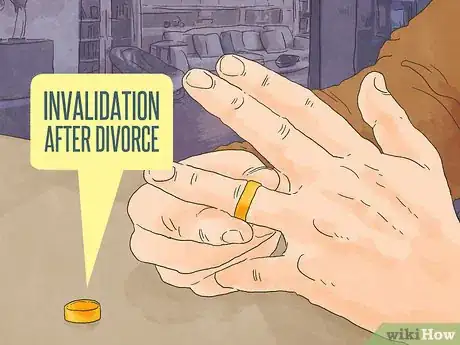This article was co-authored by Clinton M. Sandvick, JD, PhD. Clinton M. Sandvick worked as a civil litigator in California for over 7 years. He received his JD from the University of Wisconsin-Madison in 1998 and his PhD in American History from the University of Oregon in 2013.
There are 7 references cited in this article, which can be found at the bottom of the page.
This article has been viewed 40,296 times.
A beneficiary is the person or institution that you choose to receive the death benefit of your life insurance policy, retirement accounts, or pension. When choosing a beneficiary, it is important to consider who would suffer the most financially from your death, such as your children or a spouse. You must also comply with any state or federal requirements regarding beneficiaries, as well as any restrictions established by your retirement accounts or life insurance policy. Most importantly, make sure that you choose a beneficiary and update your beneficiary designation after major life events such as a marriage, divorce or the birth of a child.
Steps
Selecting a Beneficiary
-
1Check whether there are restrictions on beneficiaries. Before designating a beneficiary, you should check whether there are any restrictions on who you can name. For example, in some states and under certain federal policies your spouse must be named as your beneficiary or must sign a waiver that allows you to name a different beneficiary.
- In community property states, a spouse is entitled to half of any asset that was purchased with funds earned during marriage, including life insurance policies. Even if you failed to name your spouse as the beneficiary, if you live in a community property state he or she would still be entitled to half of any policy.[1]
- Community property states include: Arizona, California, Idaho, Louisiana, Nevada, New Mexico, Texas, Washington, and Wisconsin[2]
- When completing beneficiary designations for retirement plans or life insurance policies, ask the plan administrator whether there are any restrictions on who you can choose as your beneficiary.
- Generally, if you are single without children there are few, if any, restrictions that are placed on you as to whom you can choose as a beneficiary and you are not required to seek a waiver from any potential beneficiaries. If you fail to choose someone, the proceeds of your policy or retirement fund will go to your estate.[3]
-
2Name a primary and contingent beneficiary. Regardless of whom you choose as your beneficiary, be sure that you choose both a primary and contingent beneficiary. A primary beneficiary is the person that you designate to receive all of the proceeds from your death benefit. If the primary beneficiary predeceases you, then the death benefit will be paid to the contingent beneficiary. A contingent beneficiary is your back up beneficiary.
- Your benefit plan or life insurance policy may allow you to choose more than one contingent beneficiary, or split the proceeds between two or more contingent beneficiaries.[4]
Advertisement -
3Select your spouse. If married, most people choose their spouse as their beneficiary. Typically, your spouse is someone who would suffer financially from your death and therefore you want your death benefits to pass to him or her as quickly as possible.
- Under certain federal laws, such as the Employee Retirement Income Security Act (ERISA) that governs most federal employees’ retirement plans, spouses will receive 50 percent of your death benefit even if you choose someone else as your beneficiary.[5]
- If you are unmarried, you have few, if any, restrictions as to whom you can name as your beneficiary. You can choose as your beneficiary a partner, close friend, charity, siblings or other family members, or an educational institution.[6]
-
4Choose a child. If you have children, you may want to choose them as your beneficiary. If your children are adults and you are no longer married, you can select your children as the beneficiary and assign a percentage of the death benefit to each of them.
- If you have children who are minors, you have to be much more careful about how to assign them your death benefit. As discussed below in Avoiding Mistakes, you cannot choose minor children as your beneficiaries. Even if you have children who are young adults you may want to consider an alternative distribution of your death benefit, such as a trust.
-
5Designate a trust as your beneficiary. One way to ensure that minor children or young adult children receive the benefit of your life insurance or retirement plan is to designate a living trust as your contingent beneficiary. By establishing a living trust, you can establish how the proceeds of the death benefit are distributed without improperly naming minor children as your beneficiary.
- For example, if you have minor children, you can specify that the trust pay out funds for their support but that the children do not inherit the principle until they reach a certain age, such as 25.[7]
-
6Choose family or friends. If you are unmarried with no dependents, you may want to consider selecting a family member or friend as your beneficiary. When choosing a beneficiary, consider choosing someone who could benefit from the money and who is unlikely to predecease you.
-
7Name a charity as your beneficiary. If you are single or you have spousal consent, you can designate a favorite charity to receive the proceeds from your life insurance or retirement plan.[8]
Changing Your Beneficiary
-
1Change your beneficiary designation after divorce. If you go through a divorce, it is very important that you change your beneficiary on your life insurance or other retirement accounts unless you want your ex-spouse to be able to claim your death benefit.
- While some states have laws that automatically invalidate ex-spouses as beneficiaries, other states and some federal retirement plans do not. In fact, the Supreme Court allowed an ex-spouse to claim death benefits over a widow. Even though the deceased remarried and did not intend for his or her ex-spouse to receive the proceeds, by failing to change the designation the court ruled that the beneficiary designation remained in place.[9]
- Generally, you can easily change a beneficiary designation by contacting your plan administrator or life insurance company and ask for a change of beneficiary designation form.
- Once you complete, sign, and return the form, you can change your beneficiary.
-
2Update your beneficiary designation after remarriage. If you do not have any kids from a previous marriage, for the reasons discussed above, you will most likely choose your new spouse as your beneficiary. If you have children from a previous marriage, you may want to choose your children as your beneficiaries. While your spouse may still be entitled to a portion of your policy if you pay for it during your marriage, there are steps that you can take to make sure that your children receive part or all of your death benefits.
- If you have minor children, name a living trust as your primary beneficiary.
- If you live in a community property state, name your adult children or a living trust as the primary beneficiary and your spouse will be entitled to 50% of any premiums paid during your marriage with community/marital funds.
- Ask your new spouse to sign a consent waiving any right he or she may have to the death benefit and then name your adult children or a living trust as your beneficiary.[10]
-
3Choose a new beneficiary in the instance of a death or birth. If one of your designated beneficiaries dies, you should select a new beneficiary. Similarly, if you have a new child and you have already established a living trust as the contingent beneficiary for your death benefits, you should make sure that you add the new child as a beneficiary to the trust.[11]
-
4Be cautious when making certain changes. While you always have the option to change your beneficiary, there are some cases where an insurance company has rejected a named beneficiary. Insurance companies want all beneficiaries to have an insurable interest, which means that the beneficiary gets a benefit from the insured being alive not just when they are dead and the death benefit is paid out. Insurance companies want to make sure that beneficiaries are not tempted to harm the insured for a financial windfall. Some factors that an insurance company may consider when rejecting a beneficiary are:
- An elderly person changes their beneficiary from his or her children to a caretaker. In this instance, the insurance company may be concerned that a caretaker has undue influence over the person.
- Similarly, insurance companies may reject a beneficiary if it appears that they have coerced or placed undue duress on an insured.[12]
Avoiding Mistakes
-
1Get spousal consent in writing. Some couples may decide that they want to leave all or some of their retirement funds to a child from a previous marriage or a favorite charity rather than their spouse. If you and your spouse agree to choose someone other than your spouse as your beneficiary, you must have your spouse state in writing that they consent to a beneficiary other than themselves.
- Certain federal retirement plans or 401k plans may have a specific waiver form that your spouse must sign in order for your beneficiary designation to be valid.
- A spouse can withdraw his or her consent if the other spouse names a beneficiary other than who they originally agreed upon.[13]
-
2Do not name a minor child as your beneficiary. When completing your beneficiary designation form, do not list your minor child as your beneficiary. Life insurance companies will not pay the proceeds directly to minors. If you name a minor child, the courts will appoint a guardian to handle the funds on behalf of the child until he or she turns 18 years old.
- As discussed above, you can establish a trust for the benefit of the minor and have the funds paid into the trust, which will manage the funds until the minor reaches a certain age.
- Similarly, you may not want to name a young adult child as the beneficiary of your death benefits. There is a concern that they may spend the money frivolously and then not have the economic security later in life.[14]
-
3Check regulations regarding benefits for special needs children. If you have a special needs child, you should speak with a trust and estates attorney before naming the child as your beneficiary. Under certain federal programs, such as Medicaid, any person receiving governmental assistance may be disqualified from receiving benefits if they receive a gift or inherit more than $2,000.
- You may need to set up a special needs trust and designate the trust as the beneficiary in order to ensure that the child receives the death benefits and can still receive government assistance.[15]
-
4Do not designate your estate as your beneficiary. You should not choose your estate to receive your death benefits because your heirs will have to wait a long time to receive the funds and may need to pay estate taxes on the amount. Also, as part of your estate your death benefits can be used to pay off creditors instead of passing directly to a beneficiary.[16]
- You may want to name your estate as a final beneficiary. A final beneficiary receives your death benefits if your primary and contingent beneficiaries predecease you. This ensures that your death benefits become part of your estate and are distributed according to your wishes when you have no other beneficiaries.[17]
References
- ↑ https://www.nationwide.com/life-insurance-beneficiary-designation.jsp
- ↑ http://www.insure.com/life-insurance/spouse-right-to-life-insurance-money.html
- ↑ http://www.lawdepot.com/estate-articles/estate-planning-for-singles/#.Vs3bEFK0cm8
- ↑ http://termlife2go.com/choosing-a-beneficiary-for-life-insurance/
- ↑ http://www.401khelpcenter.com/401k_education/connor_beneficiary_designations.html#.VsIo8VK0cm8
- ↑ http://www.lawdepot.com/estate-articles/estate-planning-for-singles/#.Vs3bEFK0cm8
- ↑ http://termlife2go.com/choosing-a-beneficiary-for-life-insurance/
- ↑ http://termlife2go.com/choosing-a-beneficiary-for-life-insurance/
- ↑ http://www.insure.com/life-insurance/spouse-right-to-life-insurance-money.html
- ↑ http://www.insure.com/life-insurance/spouse-right-to-life-insurance-money.html
- ↑ http://termlife2go.com/choosing-a-beneficiary-for-life-insurance/
- ↑ http://termlife2go.com/choosing-a-beneficiary-for-life-insurance/
- ↑ http://www.nolo.com/legal-encyclopedia/if-you-don-t-want-leave-retirement-accounts-your-spouse.html
- ↑ http://www.insure.com/life-insurance/naming-life-insurance-beneficiaries.html
- ↑ http://www.insure.com/life-insurance/naming-life-insurance-beneficiaries.html
- ↑ http://www.insure.com/life-insurance/naming-life-insurance-beneficiaries.html
- ↑ http://www.insure.com/life-insurance/naming-life-insurance-beneficiaries.html







































































